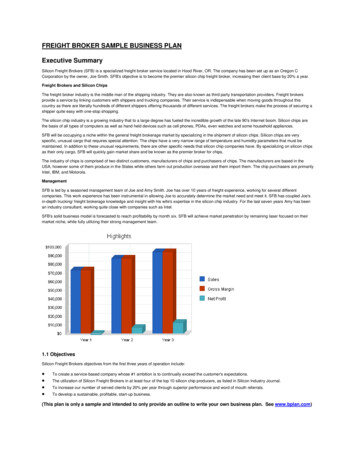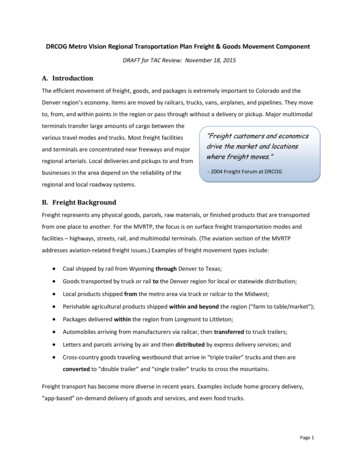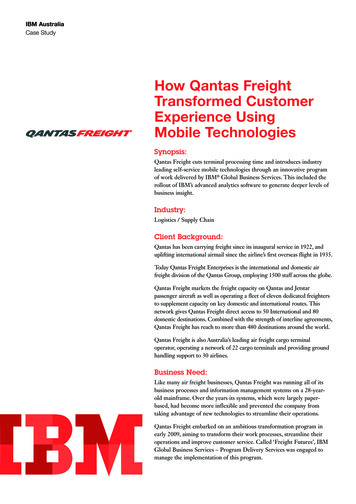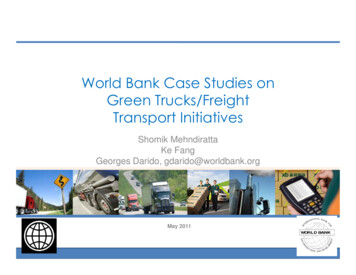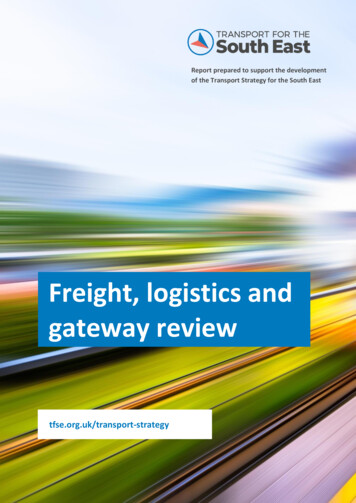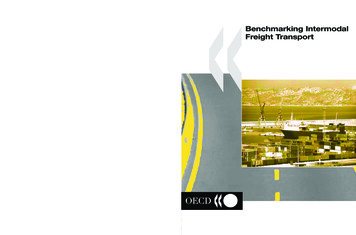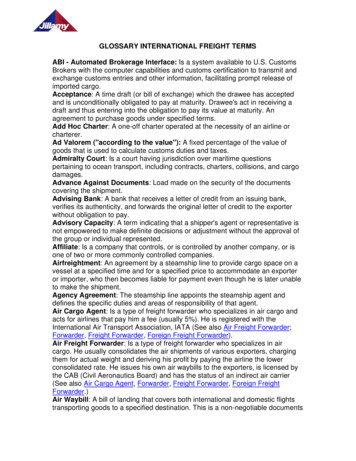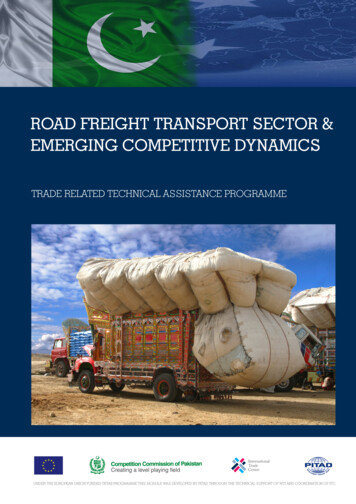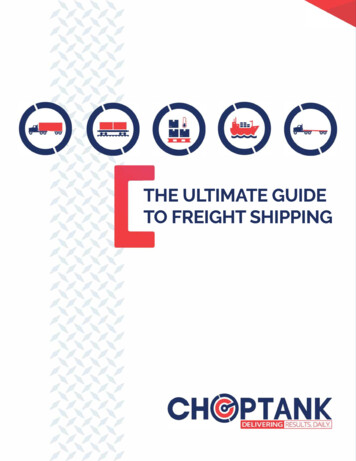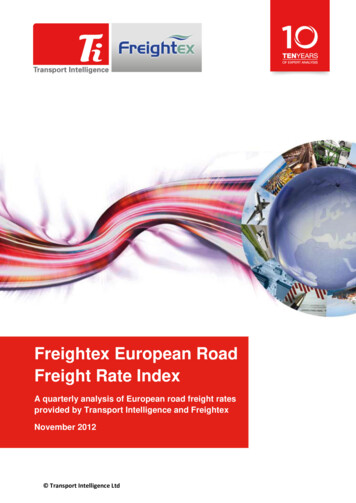
Transcription
Freightex European RoadFreight Rate IndexA quarterly analysis of European road freight ratesprovided by Transport Intelligence and FreightexNovember 2012 Transport Intelligence Ltd
Index shows European road freight rates slidingAfter rising by 20% in two years, road freight rates on key routes in WesternEurope have fallen steadily for the past five months.According to the new international road freight index compiled by Transport Intelligence using dataprovided by European freight exchange, Freightex, road freight rates have fallen 7% in the past fivemonths from their peak.By the end of May 2012, the Index (based on actual transactions settled in euros) was 21.2% higherthan in May 2010, the starting point for the index. After this date, however, rates have fallenconsistently.The rise in prices up to May 2012 had several factors behind it. Firstly, the market was undergoing asubstantial ‘bounce-back’ from the crisis point of 2009, when prices crashed. Quantifying the effectof this is difficult as rather than settle back to equilibrium, prices have remained volatile. Thisvolatility appears to be a structural issue, both in terms of demand and supply in the market.It would seem likely that the fall in prices over the past few months has been driven by fallingdemand, whilst capacity has yet to re-adjust.Consolidated Freight Index (Index of per full loads) Transport Intelligence Ltd1
The relationship between fuel and ratesClearly, the rise in the price of oil has been the single largest factor in terms of the increase in roadfreight prices over the past two years. The chart below shows the relationship between the price ofdiesel and the freight index. The sharp rises in the price of oil will also have increased the proportionof fuel in the cost of road freight. That said it is not the only factor, with demand and supply stillsignificant influences on price.Price of Diesel and European Road Freight Indices 2010-1214013012011010090802727 27 Jul 2727 2727 27May Jun 10 Aug Sep Oct Nov Dec10101010 1010 1027Jan1127 2727 2727 27 Jul 2727 2727 27Feb Mar Apr May Jun 11 Aug Sep Oct Nov Dec11 1111 11111111 1111 1127Jan1227 2727Feb Mar Apr12 1212Freightex Consolidated IndexDiesel Price Index Bounce-back from the recessionA second characteristic of the market since 2010 has been the continuing effects of the 2009 crash.Specifically, truck owners were severely affected by the first downturn in 2009 and responded byshrinking their asset base. Fewer trucks on the market resulted in higher prices, both for ‘Full TruckLoad’ (FTL) and ‘Less-than-Truck Load’ (LTL) shipments. Several big LTL providers cited this as a factorin increasing their costs: “The crisis has led to a shortage of hauliers but groupage providers have notbeen able to increase prices,” said one operator.The demand picture however, is more complicated, with large differences between southernEuropean markets and the rest of Western Europe. Unsurprisingly, demand is very weak out ofSpain, with hauliers reporting as much as a 10% decline in volumes. For the rest of Europe, demandis either flat or growing, but it is hardly fulfilling expectations. A sentiment across the sector is thatdemand is highly unpredictable. Transport Intelligence Ltd2
Market PatternThe changes in demand have also had a significant impact on the nature of some markets. Largercompanies report that the balance in cost between inbound and outbound has changed, withinbound becoming cheaper and outbound more expensive due to a shortage of loads, resulting incrude price stability. This applies to most, if not all, of Southern Europe.There has been some change in major shippers’ purchasing strategies. Some of the largest consumergoods companies have been looking to reduce their business with forwarders and larger providers,and increase their direct business with medium-sized road freight transport companies. This has onlybeen partially successful as the shippers have encountered some problems with capacity availabilityin tight markets. They have also suffered from poor customer service levels. However, this trendmay have an impact on the ability of larger LTL providers and forwarders to pass on higher costs tocustomers.‘Stickiness’ of rate increasesThe consensus amongst the larger LTL providers is that customers are more aggressive in resistingprice rises. DB Schenker’s comment in their recent report that, “Given the reserved economicoutlook, we expect the European land transport market in 2012 to post a weaker development thanin the year under review, while nevertheless remaining very favourable. Accordingly, we expect tosee a continued tense market situation and strong margin pressure in 2012” summarises theposition fairly well, with another company observing that larger customers were improving theirbuying practices. However, this is contradicted by Norbert Dentressangle’s recent statement that,“we also demonstrated our capacity to pass on increased diesel costs in the prices that we chargefor our services.”The key issue here for LTL providers is that such networks have fixed infrastructure investment asopposed to truck asset owners whose asset base is ‘semi-variable’. The problem is that volumesincreases are not sufficiently predictable for LTL providers to be confident that they can cover fixedcosts and this may depress profits for such providers and affect their investment plans adversely.An uncertain futureThe big problem is volatility. The swings in demand from month-to-month are both large andunpredictable. “We are simply not in a position to work out future developments,” said oneoperator. This is a major problem in assessing both the present state of the market and its immediatefuture. Some big players reported a strong first quarter in Germany, but a weaker second quarter,with no growth year-on-year in July. Other companies, which focus on the UK, reported only slightgrowth throughout the year, with a very modest up-tick in the second quarter. Transport Intelligence Ltd3
Individual MarketsGermany-UK (Index of per full loads)Germany has been one of the more complex markets over the past two years. On the one hand,inflationary forces have been reasonably strong, with increases in road-tax (Maut) as well as somewage pressure. However, this has been strongly mitigated by an increasing presence of CentralEuropean drivers and companies in the German market; something aided by the changes in EUcabotage rules over the period. This is reported to have made competition tough in both the FTL andLTL markets.France-UK (Index of per full loads) Transport Intelligence Ltd4
The French market has been characterised by changes on the supply side. Two large providers, Moryand Geodis, have reduced capacity, through restructuring and acquisition respectively, and this hassupported the market in otherwise tough demand conditions.Italy-UK (Index of per full loads)The rises in costs on routes east into Italy have been influenced by the increases in road tolls throughthe Mont Blanc tunnel. These are generally pegged to the rate of inflation in the Euro area, but theyhave been aggressively ‘passed through’ by operators. This is despite low and falling levels ofdemand.Spain-UK (Index of per full loads) Transport Intelligence Ltd5
Spain has been the most distressed of the major markets with falls in inbound demand reported tobe around 10%. This has affected the structure of the market, as it is more difficult to find inboundloads, driving down prices. Yet outbound capacity availability has decreased, whilst volumes haveincreased, driving up rates. Consequently, rates overall have remained roughly static over the pastfew quarters.The market has been characterised by ‘supply-side’ issues, with many Spanish hauliers going out ofbusiness. In addition, many non-Spanish shippers, LTL networks and suppliers have been reluctant totrade with Spanish hauliers out of fear of poor credit conditions. This has only exacerbated thehostile business climate for road freight providers in Spain.Other Markets:Scandinavia has seen modest growth, however the international market has become difficult with asoft supply situation. Central Europe, especially Poland, has generally seen strong demand and thesupply side is firm, leading to generally good market conditions. However, these may be weakeningfrom the second quarter. South Eastern Europe remains severely depressed, affected by thesituation in Greece.Present and Future TrendsThe two clear themes of the market at present are volatility and fuel prices. Demand remains highlyunpredictable with big swings from month-to-month. This is affecting planning by suppliers and mayhave the longer term affect of depressing investment and therefore the availability of capacity. Thisis unlikely to be as great as the trend seen in 2009, when a substantial amount of truck capacity wasremoved from the market. However, it could lead to higher prices in the medium-term due toshortages of capacity if there is a bounce-back in demand.However, the oil price remains the biggest driver of costs. At present, elevated price levels have adominant effect on road freight prices. This effect is so great that, for the moment, purchasers ofroad freight should look to projections of fuel costs as the most powerful guide to short-term costs.One of the most interesting symptoms is a likely compression in the margins of LTL providers. Acombination of higher costs of truck services, higher fuel costs and new entrants into the market arelikely to drive-down profit margins that, up until now, have been comparatively strong. Transport Intelligence Ltd6
MethodologyThe statistics on which this analysis is based are taken from FreightEx’s exchange activities andreflect the prices paid/bought for actual loads. The Consolidated Freight Index is created through theaggregation of the data on individual routes but not on a weighted basis. The routes are selected forthe quality of data. Routes that do not have data of sufficient data quality- such as size of sample orconsistency- are not used.About FreightExSince 2001, Freightex has worked to impress its many customers across Europe with its high levels ofservice and efficient transport solutions. We specialise in cross-Channel routes where our team ofexperienced freight professionals use their unique knowledge to provide our customers withexcellent prices and excellent service levels. We embrace technology to optimise traffic flows and toensure that we use available truck capacity to maximum effect. See the Freightex Service Promise.We have the flexibility to manage spot loads or long term contracts – every customer has adedicated account manager who is committed to managing their work with the greatest care andresponsibility. The company's international office is ideally situated in the Port of Dover and staffedwith multinational freight specialists. It has three further regional UK offices. It is a member of theBritish International Freight Association (Bifa) and the Chartered Institute of Logistics (CILT).www.freightex.comAbout TiTransport Intelligence (Ti) is one of the world’s leading providers of expert research and analysisdedicated to the global logistics industry. Utilising the expertise of professionals with many years ofexperience in the mail, express and logistics industry, Ti has developed a range of market leading webbased products, reports, profiles and services used by all the world’s leading logistics suppliers,consultancies and banks as well as many users of logistics services.www.transportintelligence.comMore informationFor more information about the Freightex European Road Freight Rate Index contact Thomas Cullen:tcullen@transportintelligence.com.Updated weekly, interactive European Roadhttp://www.transportintelligence.com/graphs/ Transport Intelligence LtdFreightRate Indexchartsareavailable at7
After rising by 20% in two years, road freight rates onkey routes in Western Europe have fallen steadily for the past five months. According to the new international road freight index compiled by Transport Intelligence using data provided by European freight exchange, Freightex, road freight rates have fallen in the past five 7%
